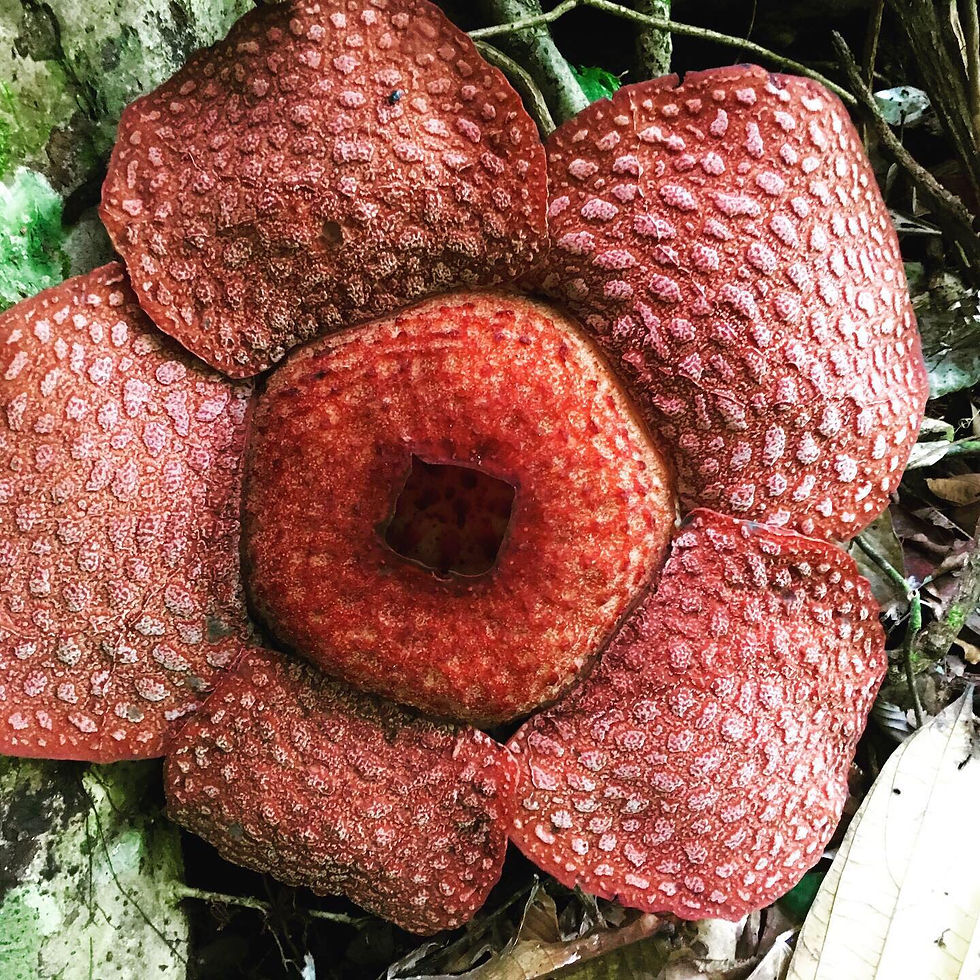In Search of the World's Tallest Flower
- SumatraOrangutanDiscovery

- Feb 28, 2020
- 4 min read
Today the Sumatra Orangutan Discovery team went on a different kind of jungle adventure. This time they were not searching for the orangutan, but for the elusive Amorphophallus titanium, the world’s tallest flower.

Our group consisted of our two adventurous guests, 75 year-old Harriet from America, and 63 year old Kay from Wales as well as our guide from Bukit Lawang, and two local guides who have been working and studying the flower for years.
We set off by motorbike from Bukit lawang to the small remote eco-tourism village of Batu Katak, an 18km journey. The drive was scenic, passing through palm oil plantations, small, typical wooden villages and finally headed for the more mountainous border of the Gunung Leuser National Park.
Batu Katak is a small traditional village of approximately 250 residents; the town consists of traditional wooden houses nestled along the Berkail River. The village really is off-the-beaten-path, and is rare to see many tourists in this area, only occasionally at the weekend does it sometimes see an influx of local tourists from Medan coming to enjoy the fresh air and BBQ by the river.

The surrounding area consists of various plantations bordering the Gunung Leuser national park, but the most important and interesting features are the karst forests; towering limestone rock cliffs and cave systems. These forests are incredibly important as they are home to the Black Gibbon, White-handed Gibbon and the critically endangered Sumatran Orangutan. It is also suggested that the karst forests create a cooler microclimate which attrubutes to the number of Rafflesia flowers growing in this area.
We set off on our trek first through the surrounding rubber plantation. Small ramshackled huts were dotted around the forest for the rubber farmers to escape from the midday sun. After, about 30 minutes we left the plantation and entered into the buffer zone of the national park. We were greeted by the howling of black gibbons on the nearby mountainside. High in the trees, we couldn't see them but their calls and hooting were magical to listen to.
We reached a small river, clear flowing water full of small fish. Our guide motioned for us to remove our shoes as he started making his way upstream in his black rubber shoes. We followed the river for the next 15 minutes, enjoying the cool feeling on our feet and the fresh air around us.
Finally we stopped at the riverbank, put back on our shoes and the guide told us we would start our ascent to the flower. It was only about 1.5 kilometers to reach the final destination, but the narrow path running up the steep densely vegetated hill was hard going. After about 30 minutes of sweaty, slippery scrambling we reached a small clearing on our right side side.

There, towering out of the vegetation was the Amorphophallus titanium. Standing at about 1 metre high, this flower was still young and not fully blooming yet, it would later grow to a staggering 3 meters in height. However, what is lacked in stature, it made up for in its smell.
In Indonesia, its name "bunga bangkai" translates to corpse flower, sitting 2 meters away from it we could all understand why. It was reminiscent of being in a fish market at the end of a long hot day. The Corpse Flower is endemic to Western Java, Central and North Sumatra. The flower is rare to see, until 1989, fewer than 30 flowerings were recorded to have occurred in botanical gardens worldwide. A lot of research has gone into why the area of Batu Katak has so many of these rare flowers. It is thought to be something about the cool limestone rocks creating a microclimate within the humid rainforest, making the perfect conditions for the flower to grow.

The flower starts life as a seed, from which a stem and leaf grow. After a period of time, an underground tuber will emerge, with the leaf and stem dying leaving behind the dormant tuber. Over a period of time, the size of the underground tuber continues to grow. After several seasons of growth, finally a inflorescence emerges, which resembles a flower.

The flower only lasts around a week. During that week the foul smell attracts pollinators, small carrion beetles, as well as flies and other insects. The flower then begins to rot, leaving behind the female part of the flower to continue to grow. For fertilization to occur there must be two plants in the same area, which given their rarity is quite a magical occurance. If fertilization is successful, the flower will produce many berry-like fruits which contain seeds, to be eaten by animals and dispersed around the jungle.
On previous treks we had been very lucky, and arrived just in time to see the full bloom of the flower. It's almost impossible to know for sure how open the flower will be, but it is equally interesting to witness the various states of the flower.

Also growing in the same area is the flower with the world's largest bloom; the Rafflesia arnoldi, which can grow to be 3 feet across and weigh up to 15 pounds!

Supporting the community of Batu Katak and their eco-conscious treks to see the flower is vitally important. This remote village is very poor, and without the support of tourism, the villagers reply on palm oil, poaching, illegal logging and other unsustainable forms of income. In addition, However, the limestone cliffs are under threat of mining from local cement companies whihc would have a devestating effect on the wildlife that thrive in the forests.
Contact us for more information on how you can support this community, or to take part in a seasonal flower trek.



Comments